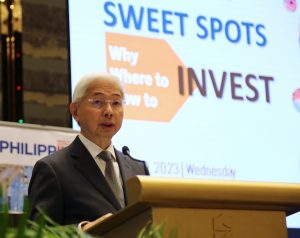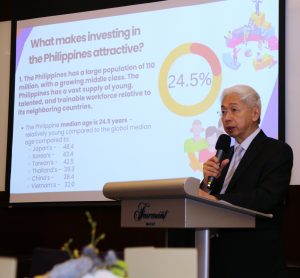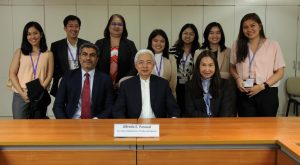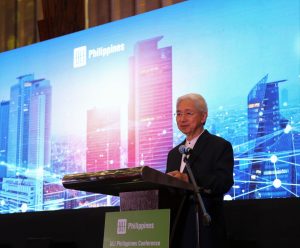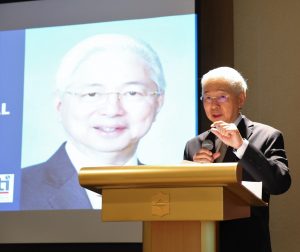Tarlac Governor Susan Yap; Italian Chamber of Commerce of the Philippines President Sergio Boero and Executive Director Lorens Ziller; leaders of other European chambers with us today; Metro Angeles Chamber of Commerce (MACCI) President Elizabeth Timbol; and guests from the private sector, including chambers and associations—a pleasant afternoon to all.
Thank you to MACCI for organizing this event. This gathering fosters collaboration among us here today. And it is an important occasion to promote investment opportunities in Subic, Clark, and Central Luzon.
As President Ferdinand R. Marcos Jr. has highlighted in recent occasions, the Philippines is on a path to solid recovery from COVID-19. Our work at the Department of Trade and Industry (DTI), together with the rest of government, has focused on helping realize our country’s robust economic expansion. To help fulfill this, we have been championing investors and businesses—like many of you—so that you may find remarkable prospects in the Philippines. Foreign direct investments like those in Subic and Clark, and in general in Central Luzon, can help drive the Philippines’ exports, make our businesses more competitive, and generate more stable and better-paying jobs for Filipinos.
With the support of our partner government units and agencies, we envision Central Luzon to build upon its already-significant contribution to our country’s economy. Central Luzon’s economy grew at 7.4 percent in 2021, rebounding against a 13.9-percent decrease in 2020. This growth rate is significantly higher than the national growth rate of 5.6 percent at the time. The growth of the region was carried by the mining and quarrying industry, human health and social work, manufacturing, and information and communication, among others.
We aim for Central Luzon to share in the prosperity that our overall economy brings, too. We have envisioned the region as an industrial heartland of the Philippines and the Asia Pacific. Central Luzon’s promise rests upon its potential to develop into an international transshipment hub, and a vibrant and competitive agricultural sector showcase. Beyond being a destination for investments, Central Luzon could also be a destination for leisure.
One of the vital growth regions in the country, Central Luzon is a strategic destination for businesses and investments. Its proximity to key cities in Asia makes it accessible within a two- to four-hour air travel. It is reachable, too, within 10 days by sea to countries like Taiwan, Japan, Hong Kong, and South Korea. The region has strong corridor accessibility to the ASEAN and Asia Pacific.
In the region, businesses may depend on supporting infrastructure. There are efficient water, power, and telecommunication facilities. Transportation and logistics are enabled by the ports and road networks I mentioned earlier. We are building synergy among the economic and tourism points of Subic, Clark, and the other seven provinces in the region. Serving as the Mid-Pacific Hub of a global logistics company, Central Luzon is also a reliable logistics hub.
We find affirmation of Central Luzon’s potential in the business activities that have been pursued in the region. The presence of 25 operating economic zones and six IPAs as well as the ongoing construction and development projects are bringing in more investments in the region. As of December 2022, there were 163 registered enterprises in the whole of Region 3. At the same time, there were 46 PEZA-registered companies in Subic and Clark. These businesses were mostly engaged in basic metals, business process outsourcing, chemicals, and electricity, gas, steam and hot water supply. They were also engaged in food products, and hotels and restaurants, among others. Generated exports from these PEZA-registered companies amounted to USD2.11 billion for January to December 2022 period. Direct jobs as of December 2022 totaled 29,433.
With examples such as Subic, Clark, and the whole of Central Luzon, we at DTI continue our aggressive investment promotion of the Philippines. Six weeks from the onset of the new year, the total investment projects approved by DTI Board of Investments (BOI) reached Php 414.3 billion. This is a surge by 142.9 percent compared with the investment projects recorded at PHP170.5 billion in the same period last year. We are optimistic about hitting PHP1.5 trillion in investment approvals for 2023.
In terms of the total foreign and local investments by region, Central Luzon ranked second with a PHP169.33-billion share to total IPA-approved investments. It also ranked first with PHP111.03 billion in the total BOI-approved investments during the period of January-December 2022.
We reiterate our commitment to an enabling environment for investors in Subic, Clark, and other strategic locations in the country. We will realize this through the implementation of game-changing economic reforms, among others. The Corporate Recovery and Tax Incentives for Enterprises Act, Retail Trade Liberalization Act; amended Public Service Act, and amended Foreign Investments Act provide rational incentives and ease restrictions on foreign ownership of certain businesses in the country.
DTI, with the support of the Philippine government, is also enabling cross-cutting mechanisms to ease investments. President Ferdinand Marcos Jr. just signed an executive order that mandates the establishment of Green Lanes for strategic investments. This will fast-track the processing of permits and licenses, and offer the Board of Investments as a single point of entry for strategic investments. Targets include projects of national significance, highly desirable projects, and foreign direct investments endorsed by our investments promotion committee. We encourage you to consider the opportunities that this mechanism will offer.
Integrated into catalyzing the growth of investments and businesses, and in enhancing ease of doing business, is connectivity. Following the President’s directives, we shall build better and more infrastructure. To support businesses, we are connecting our ecozones, trade centers, and hubs for manufacturing and logistics. As an example, it is full speed ahead for the 147-kilometer commuter rail that will link our technology industrial sites south of Manila to Clark Airport north of Manila.
When indeed the investments come in, we seek to encourage them toward our industrialization and our priority sectors. In setting out on a path to industrialization, we are building modern and dynamic industries driven by science, technology, and innovation (STI). We are keen on investments and initiatives that bring in advancements in STI. With STI, Philippine industries can become more productive, and can better compete in global markets.
Embracing Industry 4.0, and the country’s existing industrial strengths and competencies, we see four clusters as sources of growth:
1. The Industrial, Manufacturing and Transport (IMT) cluster;
2. The Technology, Media and Telecommunication (TMT) cluster;
3. The Health and Life Science (HLS) cluster; and
4. The Modern Basic Needs and Resilient Economy cluster.
Central Luzon is further enrolled in the priority industry clusters of bamboo, cacao, high-value coconut products, coffee, processed fruits and nuts, and wearables and homestyle. We invite you to consider these clusters and sectors as potential prospects.
To enable MSMEs’ contribution to regional development, DTI has broadened the “One Town, One Product” (OTOP) into a regional scope. This is based on regions’ natural endowments and comparative advantages. We are partnering with research institutions in innovating OTOP. There are already OTOP Hubs in some of our provinces, particularly Aurora, Tarlac, Bulacan, Zambales, and Pampanga. The OTOP Showroom in DTI’s Regional Office III exhibits products made with the ingenuity, creativity, and resourcefulness of MSMEs in the region. Some of these products are baskets from Nueva Ecija; food products from Bataan and Zambales; and purses from Aurora.
DTI regional offices are also working with their respective regional development councils to promote each region’s productivity and competitiveness, including those of MSMEs. DTI provides various assistance to MSMEs to help them thrive in the new normal. Among the key support of DTI to MSMEs is providing them with market access through trade fairs, market matching, trade exhibits, and missions to promote their products. The 24th Likha ng Central Luzon Trade Fair last October 2022 generated more than PHP57 million in total sales.
Another example of our initiatives relevant to the region is the establishment of Regional Inclusive Innovation Centers or RIICs. RIICs connect innovation agents and other stakeholders. Together, they advance innovation and entrepreneurship to drive regional industrialization. As an example, we have THRIVE, which stands for Technological Hive of Regional Innovation for a Vibrant Ecosystem. THRIVE Central Luzon is the official brand of the RIIC in the region. From collaborations and partnerships, it aims to boost entrepreneurial activities, create jobs, and provide access to market-oriented research and innovation that will improve the competitiveness of select industries in the region. Launched in March 2021, THRIVE Central Luzon is an inter-agency collaboration among DTI, DOST, and CHED. It is also in partnership with the academe and USAID STRIDE. Our partner higher education institutions—from Tarlac to Nueva Ecija, Bataan to Pampanga, among others—participate in capacity building and open sharing of information and databases, especially with MSMEs.
—
What we—together with partner government agencies and units—envision is a prosperous economy driven by investments, innovation, and productivity. We consider our regions to be vital in realizing this vision. We are promoting investments, industry development, and in turn, business opportunities for our people. We invite you—our current and prospective investors—to march alongside us in this endeavor. We will go town by town, city by city, province by province, and region by region, making sure that no one is left behind.
Together, let’s make it in the Philippines! *
Date of release: 28 February 2023



